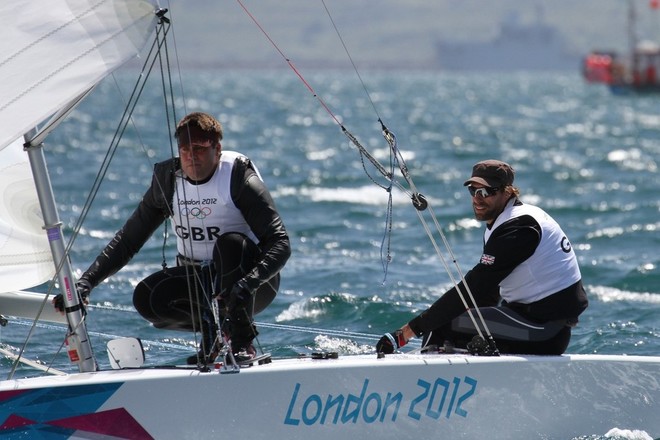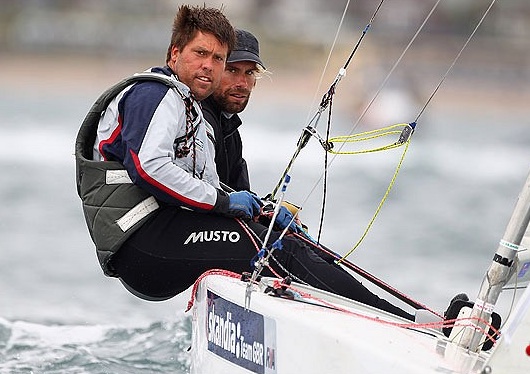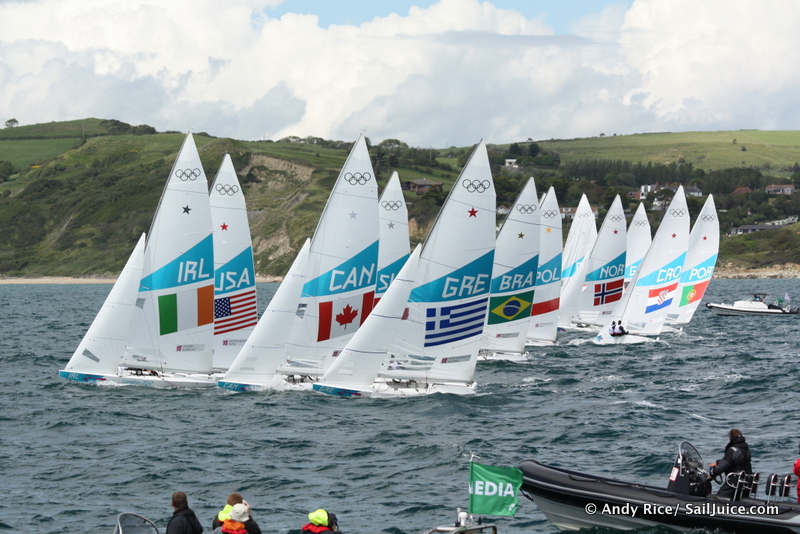Roll Tacks - September 2013
I can’t decide whether or not the unique language in sailing that we use is a good thing. The constant dumbing-down of sailing for TV audiences drives me crazy, because I think if the audience is sufficiently interested, they’ll take the time to find out what a ‘violent luff’ or a ‘Chinese gybe’ is. I don’t know about you, but I can watch and enjoy a football or rugby match without necessarily understanding every nuance or subtlety of the game.
But I was reminded just how difficult and weird our sailing language is, when I took part in Cadet Week at my home club, Stokes Bay Sailing Club. It was a good opportunity to introduce my kids to sailing for the first time. It was an eye-opener for them, but for me too. After sailing for more than 30 years, this was the first time I’d spent a week sailing with absolute beginners, both the kids and their parents. It was a reminder that learning to sail is a lot learning to drive - you have to get used to doing five or more things all at once. A bit like patting your head and rubbing your tummy, but much harder.
One of the things I soon realised that the concept of ‘up’ for towards the wind, and ‘down’ for away from the wind, was most lost on deaf ears. Understandable, when you think about it. When you’re sailing a boat on the surface of the water, you don’t really want to go ‘down’. Not unless you were on a submarine. Similarly, ‘up’ seems a bit optimistic, unless you’re sailing a foiling Moth. So the idea of ‘towards’ or ‘away’ from the wind seemed a better use of terminology, except that I soon discovered that the knowledge of where the wind is coming from is not in-built to the human psyche either.
As sailors, we get so used to the tell-tail signs of the wind direction that we take it for granted. The waves tell you where the wind is coming from, right? But it turns out this stuff isn’t at all obvious to the absolute beginner. I started to remember why many of us put burgees at the top of the mast.
I did a good deal of the Cadet Week sailing on board a Laser 16 with the owner, Ian Bugden, and about 10 kids at a time. This Laser 16 came with a roller-furling una-rig, where the sail rolls up into the mast. With a high boom and the ability to set as much or as little of the sail as you want, it is one of the safest boats imaginable, and perfect for the job of taking kids - or adults - sailing for the first time. Trouble was, most of the kids wanted to jump overboard and go swimming. Meanwhile, the Topper group were all busy capsizing.
What’s with the falling in the water thing? I thought boats were all about staying dry on top of the water. But of course, that’s not the whole story, is it! Messing about in boats is what it’s all about, and if falling off your boat is more fun than staying on board, then why not?
Overseen by the indefatigable Grace Clark, we had some serious racing talent running some of the groups including Grace’s husband Derek - 470 Olympian, current 49er coach and designer of multiple dinghy classes - and our club Commodore, Nick Harrison, coach to Iain Percy and the late Bart Simpson for London 2012. But for Cadet Week, competitive instincts were cast aside in the name of fun, and getting wet for the sake of getting wet.
Capsizing my Topper was all I wanted to do when I first taught myself to sail on Island Barn Reservoir back in 1981. I guess capsizing is the one thing you can truly claim to be good at when first learning to sail! Since then, of course, the racing bug took over and like most of us, the priority has been to avoid the capsize at all costs. But ultimately, racing is just a more structured form of messing about in boats. My first introduction to racing was to go on a racing course on the Isle of Wight, organised by Bryan Willis with expert input from John Caig, a former Fireball World Champion who saw the potential for making the Topper a one-design race boat for people who were too little to compete in the Laser (there was only the Standard rig in those days, no Radial or 4.7 options).
Back in the sepia-toned early 80s, we kids in our Toppers set out from Stokes Bay, as it happens, to sail across to Bryan’s sailing HQ at Wootton Creek. So seeing the kids messing about in boats at Cadet Week reminded me of my first time sailing on the sea, on those very same waves at Stokes Bay 30 years earlier.
Meanwhile, Bryan is better known these days as the world’s leading expert on the Racing Rules, and this summer has been chairing an international jury that has made some of the most controversial but much admired decisions in the 34th America’s Cup. As Bryan would no doubt point out to those team members of Oracle Team USA who were punished for making illegal adjustments to the team’s three AC45 catamarans, messing about in boats is fine, and should be encouraged. But this should never be confused with messing about with boats.
But I was reminded just how difficult and weird our sailing language is, when I took part in Cadet Week at my home club, Stokes Bay Sailing Club. It was a good opportunity to introduce my kids to sailing for the first time. It was an eye-opener for them, but for me too. After sailing for more than 30 years, this was the first time I’d spent a week sailing with absolute beginners, both the kids and their parents. It was a reminder that learning to sail is a lot learning to drive - you have to get used to doing five or more things all at once. A bit like patting your head and rubbing your tummy, but much harder.
One of the things I soon realised that the concept of ‘up’ for towards the wind, and ‘down’ for away from the wind, was most lost on deaf ears. Understandable, when you think about it. When you’re sailing a boat on the surface of the water, you don’t really want to go ‘down’. Not unless you were on a submarine. Similarly, ‘up’ seems a bit optimistic, unless you’re sailing a foiling Moth. So the idea of ‘towards’ or ‘away’ from the wind seemed a better use of terminology, except that I soon discovered that the knowledge of where the wind is coming from is not in-built to the human psyche either.
As sailors, we get so used to the tell-tail signs of the wind direction that we take it for granted. The waves tell you where the wind is coming from, right? But it turns out this stuff isn’t at all obvious to the absolute beginner. I started to remember why many of us put burgees at the top of the mast.
I did a good deal of the Cadet Week sailing on board a Laser 16 with the owner, Ian Bugden, and about 10 kids at a time. This Laser 16 came with a roller-furling una-rig, where the sail rolls up into the mast. With a high boom and the ability to set as much or as little of the sail as you want, it is one of the safest boats imaginable, and perfect for the job of taking kids - or adults - sailing for the first time. Trouble was, most of the kids wanted to jump overboard and go swimming. Meanwhile, the Topper group were all busy capsizing.
What’s with the falling in the water thing? I thought boats were all about staying dry on top of the water. But of course, that’s not the whole story, is it! Messing about in boats is what it’s all about, and if falling off your boat is more fun than staying on board, then why not?
Overseen by the indefatigable Grace Clark, we had some serious racing talent running some of the groups including Grace’s husband Derek - 470 Olympian, current 49er coach and designer of multiple dinghy classes - and our club Commodore, Nick Harrison, coach to Iain Percy and the late Bart Simpson for London 2012. But for Cadet Week, competitive instincts were cast aside in the name of fun, and getting wet for the sake of getting wet.
Capsizing my Topper was all I wanted to do when I first taught myself to sail on Island Barn Reservoir back in 1981. I guess capsizing is the one thing you can truly claim to be good at when first learning to sail! Since then, of course, the racing bug took over and like most of us, the priority has been to avoid the capsize at all costs. But ultimately, racing is just a more structured form of messing about in boats. My first introduction to racing was to go on a racing course on the Isle of Wight, organised by Bryan Willis with expert input from John Caig, a former Fireball World Champion who saw the potential for making the Topper a one-design race boat for people who were too little to compete in the Laser (there was only the Standard rig in those days, no Radial or 4.7 options).
Back in the sepia-toned early 80s, we kids in our Toppers set out from Stokes Bay, as it happens, to sail across to Bryan’s sailing HQ at Wootton Creek. So seeing the kids messing about in boats at Cadet Week reminded me of my first time sailing on the sea, on those very same waves at Stokes Bay 30 years earlier.
Meanwhile, Bryan is better known these days as the world’s leading expert on the Racing Rules, and this summer has been chairing an international jury that has made some of the most controversial but much admired decisions in the 34th America’s Cup. As Bryan would no doubt point out to those team members of Oracle Team USA who were punished for making illegal adjustments to the team’s three AC45 catamarans, messing about in boats is fine, and should be encouraged. But this should never be confused with messing about with boats.
Related Articles

Bart Simpson Interview - Part 2
Read More

By the end of 2002, Bart’s sailing and his results had gone downhill. “I ended up trying to beat Ben rather than trying to sail my best.” He took himself to a psychologist. “I wasn’t thinking the right things. He taught me to refocus on sailing the best you can rather than trying to beat anyone else. He helped get my brain back on track, and I made some steps forwards, focusing on improving my own performance rather than worrying about anyone else.”

Bart Simpson Interview - Part 1
Read More

Could there be any reason to believe that a team that had just finished 52nd in the Star World Championships had any hope of winning a medal at the Olympic Games later in the year? On the face of it that question seems like a no-brainer. How could any team have serious designs on a top three at the Games, let along winning gold? But if you know that the team in question is Iain Percy and Andrew Simpson, and you know anything of what these sailors have achieved, then you might change your view.

Shooting Stars and Photo Finishes
 Read More
Read More
Halfway through the opening Star race, the Germans had a beautiful lead with defending Olympic champions Iain Percy and Bart Simpson looking comfortably in the top three as they sailed up the second beat.....

Roll Tacks - July 2012
Was the Olympic regatta a success? Yes, of course it was! It would be churlish to suggest otherwise. But before we can answer the question, we really need to consider whose point of view we’re talking about.
Read More

Roll Tacks - October 2013
Reporting at the Seiko 49er World Championships in Marseille gave me the chance to catch up with Nathan Outteridge who was fresh from his rollercoaster year in San Francisco as helmsman of Artemis Racing’s AC72.
Read More
